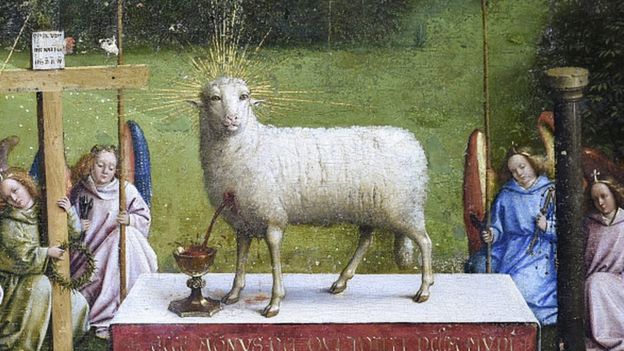
The gospel of John is both curious and magnificent in its divergence from the synoptic gospels of Mark, Matthew, and Luke. Early in John, another John, the baptizer, looks to Jesus and says "behold the lamb of God who takes away the sins of the world." This metaphor reflects verses in the prophets Isaiah and Jeremiah which have been interpreted often as precursors to Jesus as the Christ, whose death on the cross is also reflected in eucharistic or communion language. In most Protestant churches we don't hear that phrase often anymore, but those of us who are older understand its origins.
Not surprisingly this iconography is prevalent in the art of the Middle Ages and the Renaissance period. Regal looking lambs with blood gushing forth or propping up crosses may seem odd to us, but those who gazed about these paintings and stained glass would have understood what they represented.

The Ghent Altarpiece's Lamb of God, before and after restoration
One of the better known works is within the complex 15th century Ghent Altarpiece by the Van Eyck brothers. A recent restoration has revealed that the lamb representing Christ originally had an eerily human countenance, although perhaps not all that strange given the sheep is meant to be specifically anthropomorphic.
I know, I know, it all seems weird, and why would you want to read about this? With my art history background it does remind me that we have our imagery for just about everything, including corporate logos. Why is a sheep-like Jesus from 500 years ago less important a "brand" than the Nike swoosh from the 20th century?
Now every time we see a lamb you'll be wondering who's staring back at you!

No comments:
Post a Comment